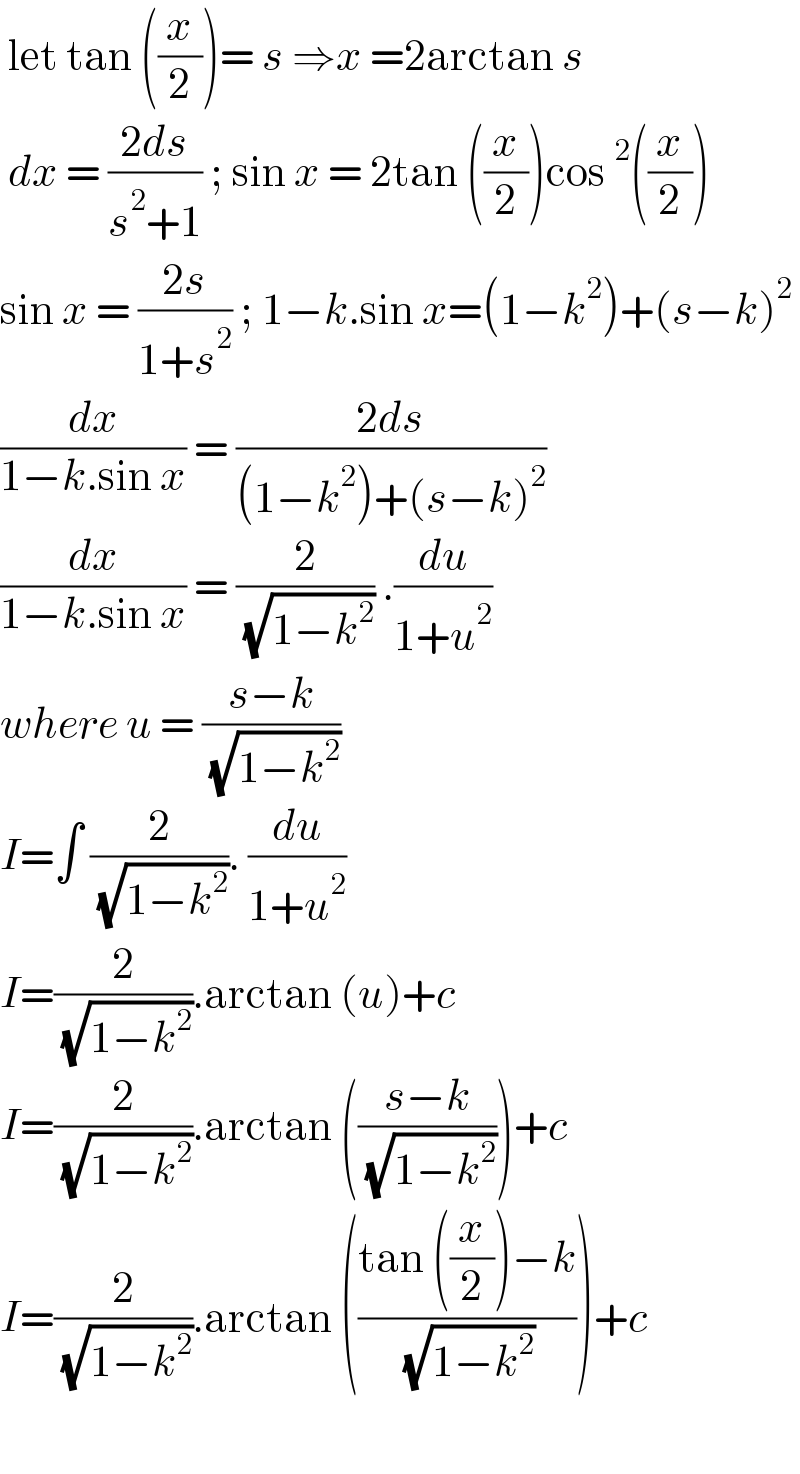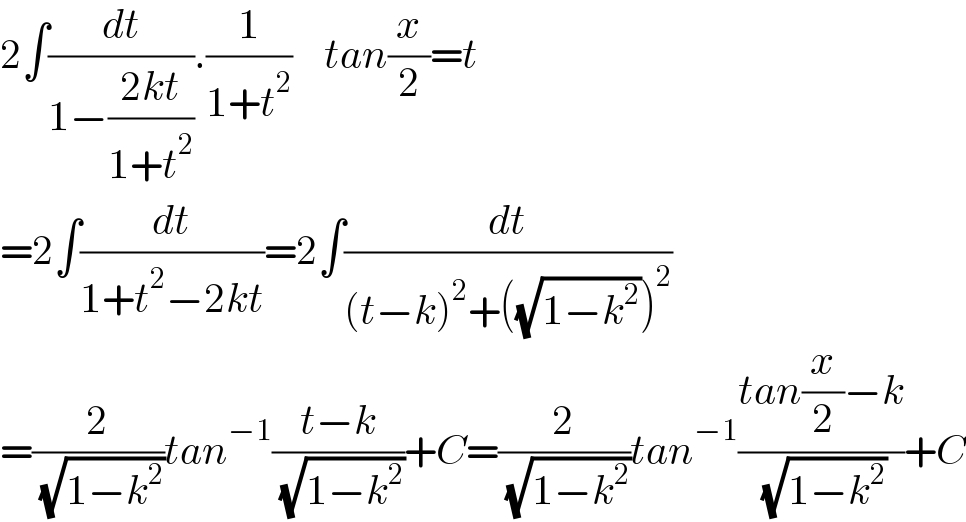
Question Number 130616 by bramlexs22 last updated on 27/Jan/21

$$\:\int\:\frac{\mathrm{dx}}{\mathrm{1}−\mathrm{k}.\mathrm{sin}\:\mathrm{x}}\:?\:\mathrm{where}\:\mid\mathrm{k}\mid<\mathrm{1} \\ $$
Answered by EDWIN88 last updated on 27/Jan/21

$$\:\mathrm{let}\:\mathrm{tan}\:\left(\frac{{x}}{\mathrm{2}}\right)=\:{s}\:\Rightarrow{x}\:=\mathrm{2arctan}\:{s} \\ $$ $$\:{dx}\:=\:\frac{\mathrm{2}{ds}}{{s}^{\mathrm{2}} +\mathrm{1}}\:;\:\mathrm{sin}\:{x}\:=\:\mathrm{2tan}\:\left(\frac{{x}}{\mathrm{2}}\right)\mathrm{cos}\:^{\mathrm{2}} \left(\frac{{x}}{\mathrm{2}}\right) \\ $$ $$\mathrm{sin}\:{x}\:=\:\frac{\mathrm{2}{s}}{\mathrm{1}+{s}^{\mathrm{2}} }\:;\:\mathrm{1}−{k}.\mathrm{sin}\:{x}=\left(\mathrm{1}−{k}^{\mathrm{2}} \right)+\left({s}−{k}\right)^{\mathrm{2}} \\ $$ $$\frac{{dx}}{\mathrm{1}−{k}.\mathrm{sin}\:{x}}\:=\:\frac{\mathrm{2}{ds}}{\left(\mathrm{1}−{k}^{\mathrm{2}} \right)+\left({s}−{k}\right)^{\mathrm{2}} } \\ $$ $$\frac{{dx}}{\mathrm{1}−{k}.\mathrm{sin}\:{x}}\:=\:\frac{\mathrm{2}}{\:\sqrt{\mathrm{1}−{k}^{\mathrm{2}} }}\:.\frac{{du}}{\mathrm{1}+{u}^{\mathrm{2}} } \\ $$ $${where}\:{u}\:=\:\frac{{s}−{k}}{\:\sqrt{\mathrm{1}−{k}^{\mathrm{2}} }} \\ $$ $${I}=\int\:\frac{\mathrm{2}}{\:\sqrt{\mathrm{1}−{k}^{\mathrm{2}} }}.\:\frac{{du}}{\mathrm{1}+{u}^{\mathrm{2}} } \\ $$ $${I}=\frac{\mathrm{2}}{\:\sqrt{\mathrm{1}−{k}^{\mathrm{2}} }}.\mathrm{arctan}\:\left({u}\right)+{c} \\ $$ $${I}=\frac{\mathrm{2}}{\:\sqrt{\mathrm{1}−{k}^{\mathrm{2}} }}.\mathrm{arctan}\:\left(\frac{{s}−{k}}{\:\sqrt{\mathrm{1}−{k}^{\mathrm{2}} }}\right)+{c} \\ $$ $${I}=\frac{\mathrm{2}}{\:\sqrt{\mathrm{1}−{k}^{\mathrm{2}} }}.\mathrm{arctan}\:\left(\frac{\mathrm{tan}\:\left(\frac{{x}}{\mathrm{2}}\right)−{k}}{\:\sqrt{\mathrm{1}−{k}^{\mathrm{2}} }}\right)+{c}\: \\ $$ $$\: \\ $$
Answered by Dwaipayan Shikari last updated on 27/Jan/21

$$\mathrm{2}\int\frac{{dt}}{\mathrm{1}−\frac{\mathrm{2}{kt}}{\mathrm{1}+{t}^{\mathrm{2}} }}.\frac{\mathrm{1}}{\mathrm{1}+{t}^{\mathrm{2}} }\:\:\:\:{tan}\frac{{x}}{\mathrm{2}}={t} \\ $$ $$=\mathrm{2}\int\frac{{dt}}{\mathrm{1}+{t}^{\mathrm{2}} −\mathrm{2}{kt}}=\mathrm{2}\int\frac{{dt}}{\left({t}−{k}\right)^{\mathrm{2}} +\left(\sqrt{\mathrm{1}−{k}^{\mathrm{2}} }\right)^{\mathrm{2}} } \\ $$ $$=\frac{\mathrm{2}}{\:\sqrt{\mathrm{1}−{k}^{\mathrm{2}} }}{tan}^{−\mathrm{1}} \frac{{t}−{k}}{\:\sqrt{\mathrm{1}−{k}^{\mathrm{2}} }}+{C}=\frac{\mathrm{2}}{\:\sqrt{\mathrm{1}−{k}^{\mathrm{2}} }}{tan}^{−\mathrm{1}} \frac{{tan}\frac{{x}}{\mathrm{2}}−{k}}{\:\sqrt{\mathrm{1}−{k}^{\mathrm{2}} }}+{C} \\ $$
